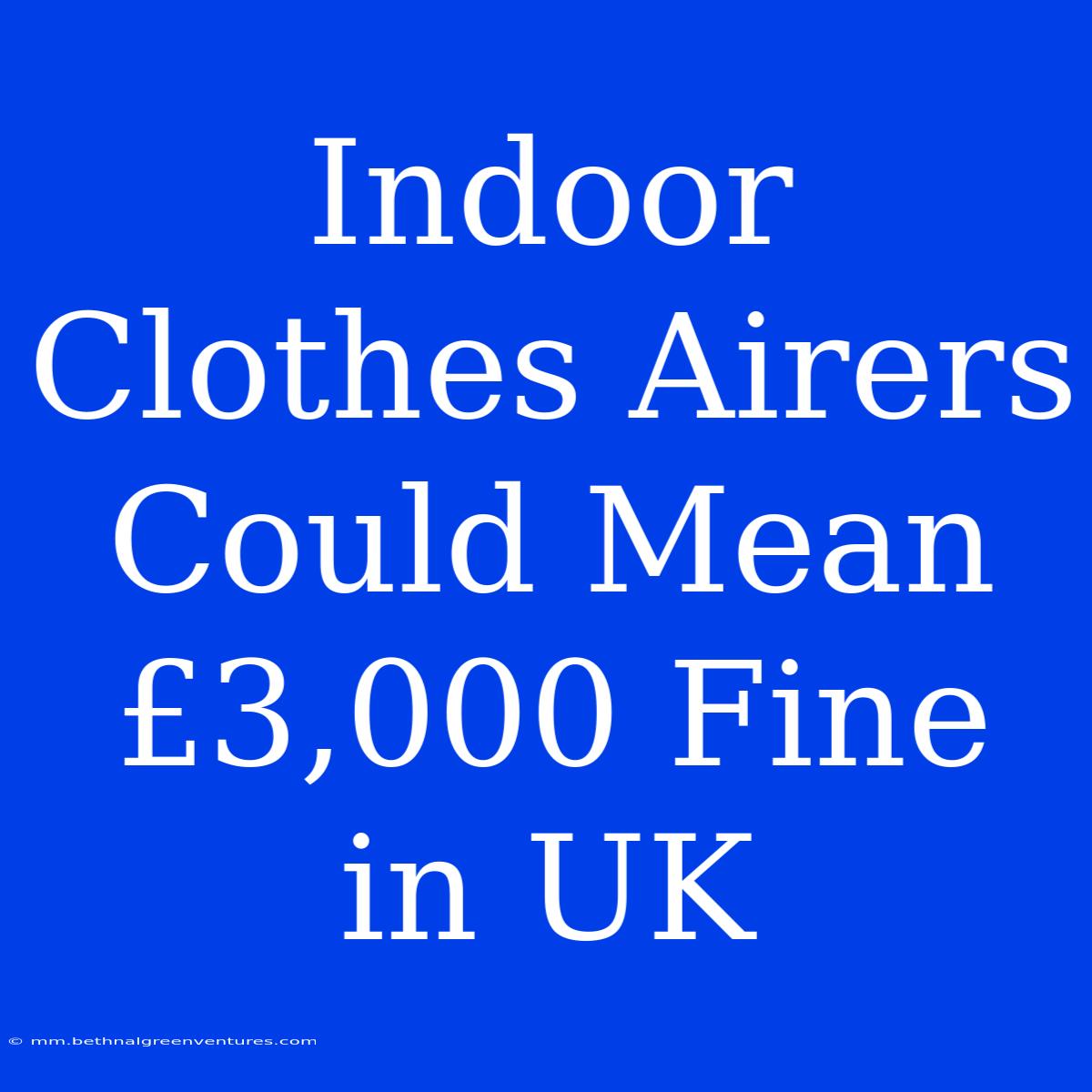Drying Your Laundry Indoors? A £3,000 Fine Could Be Hanging Over Your Head
Are you one of the many Britons who rely on indoor clothes airers during the colder months? Be warned: using an indoor clothes airer could land you with a hefty £3,000 fine! This might sound like a drastic measure, but it's a crucial point to consider as homeowners navigate the UK's complex housing regulations.
This topic is important for homeowners in the UK because it highlights the potential legal repercussions of seemingly innocent actions. The UK government enforces stringent rules on home energy efficiency, aiming to curb carbon emissions and promote sustainable practices. Improper ventilation practices, including the overuse of indoor clothes airers, can contribute to condensation and mould growth, ultimately affecting the energy efficiency of a home.
This article explores the regulations behind the £3,000 fine, analyzes the implications for homeowners, and provides practical tips to ensure compliance. We've researched the relevant UK legislation, consulted expert opinions, and examined case studies to provide a comprehensive overview of this vital topic.
Key takeaways for homeowners
| Key Takeaway | Explanation |
|---|---|
| Indoor clothes airers can trigger fines | Using an indoor clothes airer excessively can increase condensation and mould growth, potentially violating UK regulations. |
| Energy efficiency regulations are crucial | Homeowners are responsible for maintaining their property's energy efficiency standards, which includes ventilation and moisture control. |
| Potential fines are significant | Failure to comply with energy efficiency regulations can result in fines of up to £3,000. |
| Alternative drying solutions are available | Homeowners can explore alternative drying methods like dehumidifiers, heated drying racks, or outdoor drying options. |
| Professional advice is recommended | Consulting an energy assessor or qualified professional can provide personalized guidance and ensure compliance. |
Indoor Clothes Airers and the Law
The UK's energy efficiency regulations are enforced through the Energy Performance Certificate (EPC) system. This system categorizes homes based on their energy performance, with higher ratings indicating greater efficiency.
The £3,000 fine stems from the potential violation of the EPC regulations. Improper ventilation practices, such as excessive use of indoor clothes airers, can contribute to excessive moisture build-up and mould growth. This negatively impacts the home's energy efficiency, potentially leading to a lower EPC rating. Homeowners with EPC ratings below certain thresholds can face penalties.
The Impact of Condensation and Mould
Condensation and mould growth are the primary concerns related to excessive indoor drying. They pose significant risks to homeowners:
1. Health Risks:
- Mould can trigger respiratory problems, allergies, and other health issues.
- Children, elderly individuals, and those with pre-existing respiratory conditions are particularly vulnerable.
2. Property Damage:
- Mould can damage walls, ceilings, furniture, and other household items, leading to costly repairs.
- Uncontrolled moisture can also lead to structural damage, affecting the overall integrity of the property.
3. Financial Implications:
- Fines for non-compliance with energy efficiency regulations can reach £3,000.
- Repairing mould damage and addressing ventilation issues can also involve significant expenses.
Mitigating Risks and Staying Compliant
Homeowners have several strategies to mitigate the risks associated with indoor drying and ensure compliance with UK regulations:
1. Ventilation:
- Open windows: Regularly ventilate the home, especially after showering, cooking, or drying laundry.
- Use extractor fans: Ensure extractor fans in kitchens and bathrooms are functional and used regularly.
- Ensure adequate ventilation: Consult a professional to assess and address potential ventilation deficiencies.
2. Drying Solutions:
- Dehumidifiers: Use a dehumidifier to control moisture levels in the air.
- Heated drying racks: Utilize a heated drying rack for quicker and more efficient drying, potentially reducing condensation.
- Outdoor drying: Opt for outdoor drying whenever possible, especially during warmer months.
3. Seek Professional Advice:
- Consult an energy assessor: A qualified energy assessor can provide personalized guidance on improving your home's energy efficiency and meeting regulatory requirements.
- Hire a professional contractor: If you suspect ventilation issues, hire a professional to address the problem.
FAQs
Q: What are the specific rules regarding indoor drying?
A: The UK's energy efficiency regulations do not explicitly prohibit indoor drying. However, the rules emphasize maintaining a healthy and energy-efficient home. Excessive indoor drying, which can contribute to condensation and mould growth, may be considered a violation of these regulations.
Q: What are the consequences of a low EPC rating?
A: A low EPC rating can affect a property's value and marketability. It can also lead to higher energy bills. Additionally, homeowners with EPC ratings below certain thresholds can face penalties.
Q: What are the best alternatives to indoor clothes airers?
A: Dehumidifiers, heated drying racks, and outdoor drying options are all viable alternatives. Consider your budget, space constraints, and climate when making a decision.
Q: How can I prevent mould growth in my home?
A: Maintaining good ventilation, controlling moisture levels, and addressing any leaks or plumbing issues are crucial for preventing mould growth. Regular cleaning and inspecting areas prone to moisture buildup is also essential.
Tips for Managing Indoor Drying
- Minimize indoor drying: Dry laundry outdoors whenever possible.
- Dry laundry in small batches: Avoid drying large amounts of laundry indoors at once.
- Ventilate well: Ensure adequate ventilation during and after drying.
- Use a dehumidifier: Employ a dehumidifier in damp areas to control moisture levels.
- Inspect for leaks: Address any leaks or plumbing issues promptly to prevent moisture accumulation.
Conclusion
The potential £3,000 fine for excessive indoor drying serves as a stark reminder of the importance of energy efficiency and proper ventilation practices in the UK. While drying laundry indoors may seem convenient, it's crucial to be aware of the potential consequences. By embracing responsible drying habits, investing in alternative solutions, and seeking professional advice when necessary, homeowners can protect their homes, their health, and their wallets.
